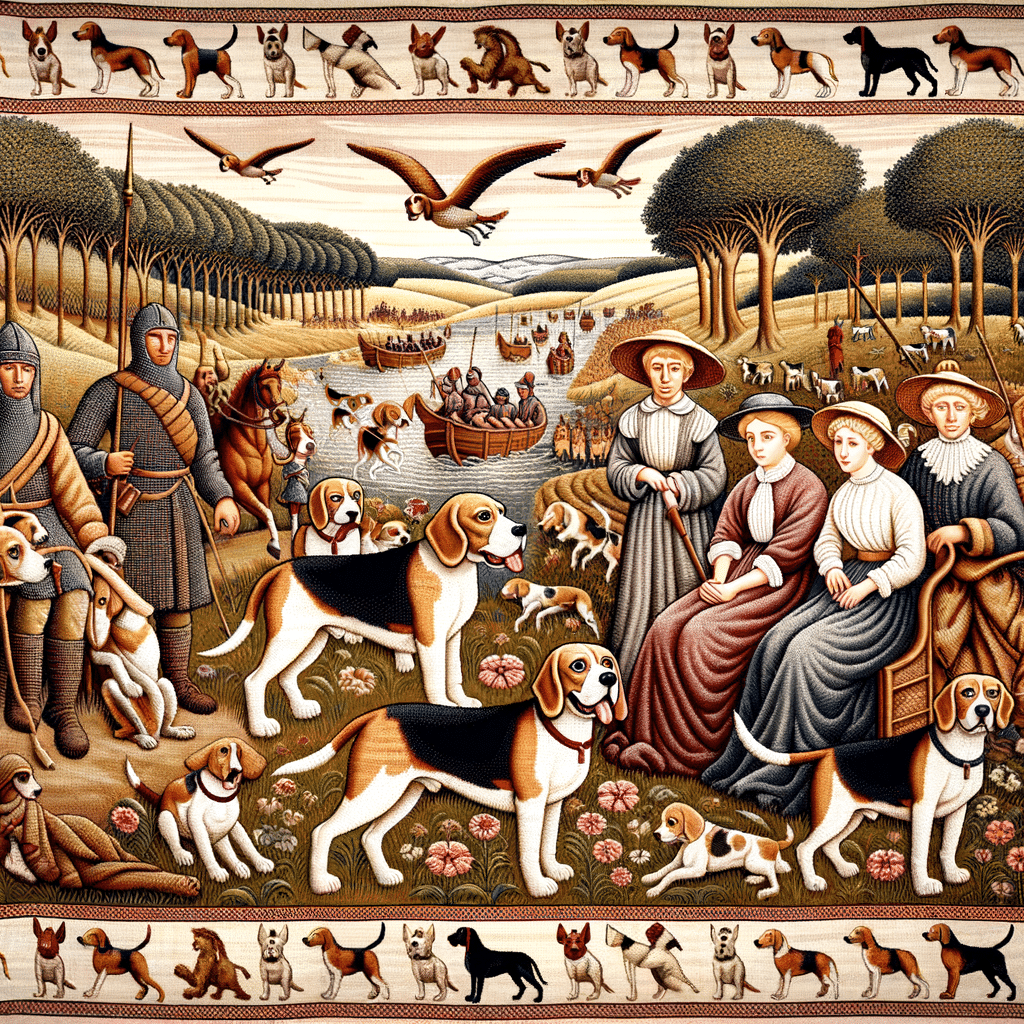In This Article
Beagles are a popular dog breed known for their keen sense of smell and tracking abilities. Originally bred for hunting small animals, beagles are now cherished family pets recognized by their sturdy build, floppy ears, and distinctive tri-colored coat.
With a history dating back to Roman times, beagles have played various roles, evolving from skilled hunters to loyal and affectionate companions. Their friendly and gentle temperament makes them an excellent choice for families.
Although beagles are small to medium-sized, they are hardy and energetic, requiring regular exercise to maintain their health and happiness. Their short coat is relatively low maintenance, but they benefit from regular grooming and enjoy human interaction. Beagles are also known for their tendency to vocalize, often communicating through bays, barks, and howls, which can be managed with proper dog training and socialization from a young age.
Highlights
- Beagles are scent hounds with a history of hunting and companionship.
- They are characterized by their floppy ears, tri-colored coat, and amiable nature.
- Regular exercise, grooming, and training are essential in a beagle's care.
Origins and History
The beagle is a breed with a rich history and a well-documented lineage. As these dogs originated from ancient times, the breed underwent significant development in England and had a historically important role as a hunting companion.
Breed Development
The breed history of the beagle can be traced back to ancient Greece, where small hound-type dogs were used for hunting. These dogs likely arrived in England during the Roman conquests.
In Great Britain, they were crossbred with various hounds to optimize their hunting capabilities. The Talbot Hound, which came to England with William the Conqueror in the 11th century, is considered a significant ancestor of the modern beagle. Over time, English breeders developed the beagle by incorporating other breeds, such as the Harrier, the Foxhound, and the St. Hubert Hound, focusing on enhancing scenting ability and stamina.
The American Kennel Club acknowledged the beagle as a breed in 1885. In the 18th century, smaller versions of the breed known as “Pocket Beagles” were popular with hunters on foot in England and Wales. However, the breed as we know it today was first seen in the 19th century, with attributes like determination, a keen sense of smell, and a tractable nature.
Historical Roles
The primary role of beagles throughout history has been related to hunting. They were valued for their ability to hunt in packs or alone for small to medium-sized game, like rabbits and hares. Literary figures like Chaucer and Shakespeare noted the breed’s historical significance and prestige among hunters.
In France, similar hounds, including the Basset Hound, were developed for similar purposes. Conversely, bloodhounds, renowned for their tracking abilities, influenced the development of many hound breeds, though the extent of their contribution to the beagle’s lineage is less defined. The beagle’s size, appearance, and friendly temperament made them invaluable hunters and esteemed companions for centuries.
Physical Characteristics
The beagle is a distinct breed, renowned for its keen sense of smell and compact yet sturdy body. They display a range of physical traits that make them charming and durable canines.
Appearance
Beagles have a smooth and weather-resistant short coat. Their fur colors often feature black, tan, and white in various patterns, including ticking or larger patches of single colors. The breed is sometimes noted for its cute demeanor due to its expressive face, floppy ears, and friendly eyes. Beagles are predisposed to conditions like cherry eye, a protrusion of the gland under the eyelid. This may require veterinary attention.
Size and Weight
Height (at withers) & weight
- 13 inches, 18-30 lbs
- 15 inches, 18-30 lbs
Beagles come in two average heights and typically weigh 18 to 30 pounds. This hound dog’s stature is robust and should be monitored to avoid issues like hip dysplasia. This is a genetic condition common in overweight or improperly bred dogs.
Temperament and Behavior
Beagles are renowned for their amiable nature and high-spirited character. They are a friendly and energetic companion, ideal for families and active individuals.
Personality Traits
Beagles exude a cheerful disposition and consistently display a playful and gentle temperament. They are known for their loyalty and make excellent companions. These dogs are also curious, intelligent, and have a refined sense of smell.
- Friendly: Beagles typically exhibit friendliness towards people and other dogs.
- Curious: Their curiosity often leads them to explore and follow intriguing scents.
- Loyal: Beagles form strong bonds with their families.
- Playful: A high energy level contributes to playful behavior, especially in young dogs.
Behavioral Tendencies
While beagles are generally easygoing, they can exhibit stubbornness, which may challenge training and routine care. Their active nature requires regular exercise to prevent destructive behavior. A strong tendency to bark or howl is a throwback to their history as hunting dogs.
- Energetic and active: They require daily physical activity to maintain their health and happiness.
- Stubborn: Training must be consistent and patient due to their sometimes obstinate demeanor.
- Sense of smell: Their acute olfaction may make them easily distracted by scents.
- Good with kids: Their gentle nature makes them great pets for households with children.
Care and Management
Routine care and management of beagles include good nutrition, consistent training, and adequate exercise. They’re known for their robust appetites and vibrant energy levels, requiring a balanced approach to their physical and mental well-being.
Health and Nutrition
A balanced, protein-rich diet is essential to maintain a beagle’s health. The best dog food for beagles typically contains real meat, whole grains, and vegetables, with no artificial fillers. A specific feeding schedule helps prevent overeating, which is common in this breed due to their hearty appetite.
Dog nutrition is vital to avoid common health problems like obesity, hypothyroidism, and ear infections. Regular vet check-ups are advisable to manage conditions like ear infections and monitor the beagle’s health, including monitoring for signs of allergies or seizures.
Feeding Guide:
- Puppies (under six months): 3-4 meals daily
- Adults: 2 meals daily
Training and Exercise
Beagles require consistent training from an early age, focusing on obedience and establishing boundaries. As scent hounds, they have a strong instinct to follow scents, which makes a fenced-in yard ideal for safe exercise. Daily walks and playtime are essential to meet their exercise requirements. Exercise prevents behavioral issues like excessive barking or howling and ensures the dog stays fit and healthy.
Exercise ideas for beagles should include:
- Daily walks: 30 minutes to 1 hour
- Play: Fetch, scent games, agility training
Combining physical activity and mental stimulation helps manage their energy levels and natural hunting instincts. Training can be challenging due to the dog’s independent nature, but positive reinforcement helps build a strong connection between the pet and the family. Beagles thrive as house pets and hunting dogs, making them versatile companions for families or individuals engaged in outdoor activities like rabbit hunting.
Frequently Asked Questions
This section offers concise, factual answers that prospective and current beagle owners will find helpful.
What type of temperament can be expected from a beagle?
The beagle is known for being curious and merry. They are typically good-natured and friendly with families and other dogs.
What are the primary characteristics of beagles?
Beagles are small to medium-sized dogs recognized for their keen sense of smell and tracking instincts. They have a sturdy build, short hair, and a distinctive bark called a “bay.”
What should be considered before deciding on a beagle as a pet?
Prospective owners should consider the beagle’s need for exercise, their tendency to follow scents that can lead to wandering, and their social nature, which may require companionship to prevent separation anxiety.
How does the beagle breed stand out among dog breeds?
Beagles are exceptional scent hounds, often employed in various detection roles because of their acute sense of smell. They also have a generally cheerful demeanor and expressive eyes that people find appealing.
What is an appropriate diet for a beagle?
A beagle’s diet should be well-balanced and portion-controlled to prevent obesity, a common issue in the breed. Quality commercial dog food or a diet recommended by a veterinarian is advisable.
What are the advantages of owning a beagle?
Beagles are adaptable and adaptable to various living situations. They are good with children and other pets, making them an excellent choice for a family dog. Their size makes them suitable for houses and apartments.






